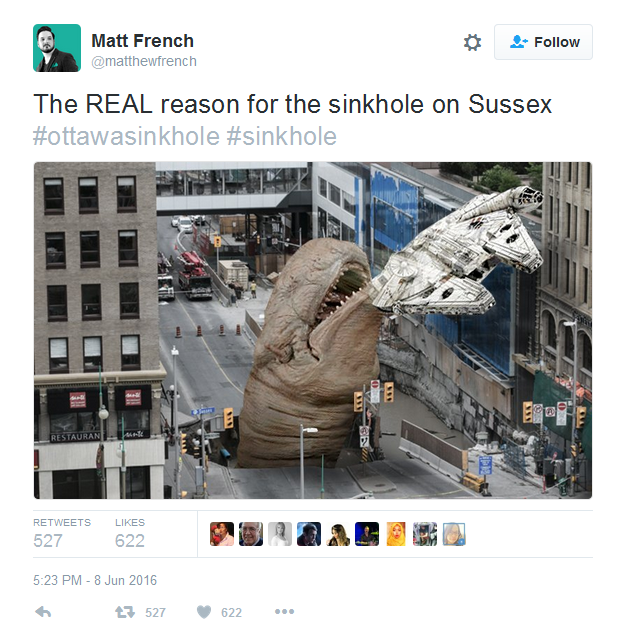Sinkhole still stymies downtown Ottawa

While the root cause of the sinkhole has not been fully determined, theories abound on social media, such as this widely retweeted image from Matthew French
Ottawa’s Rideau Street bottomed out on June 8. At around 10:30 that morning, a sinkhole developed near the intersection with Sussex Drive, arguably one of the busiest and most prominent corners in the downtown area. Thousands of people walk and drive through it each day. It’s two blocks from Parliament Hill and in between the Rideau Centre shopping mall, the By Ward Market, and the Chateau Laurier hotel. Fortunately, in the block where the sinkhole opened up, Rideau Street is closed to most traffic due to construction nearby on the light rail line and a major overhaul of the Rideau Centre. A minivan owned by a locksmith business was parked in front of the Chapters bookstore and was just at the edge of the hole. News reports said the driver of the vehicle asked police officers if he could go in and retrieve it but they said no. Seconds later, the hole expanded and the minivan was sucked in.

Crews on a Friday evening at the site of the Rideau Street sinkhole. The Rideau Centre mall is at the left. Photo by James Morgan
The exact cause of the sinkhole hasn’t been fully determined, but a water main under the street broke and gushing water washed away soil and made the ground unstable. The dirt in the area is mostly sand and gravel which washes away easily. Experts are trying to figure out if the tunnel work for the light rail project underway several hundred feet below the street was a factor. A 985 foot/300 meter section of the tunnel was flooded with water after the sinkhole opened up and crews had to pump it all out. Construction crews worked around the clock in the days following the appearance of the hole. First they filled it with literally tons of concrete. They weren’t able to salvage the minivan, it’s down there for good, encased in concrete as something for future archaeologists to study. The sinkhole cut power, telephone, and gas lines too. Utility workers were in the area for several days after trying to restore service.
The fact the sinkhole formed at such a busy place where so much development has taken place over the decades—and will continue to take place—creates a dilemma for property owners and city planners. Does too much building make the ground it’s happening on more unstable? Were records of past construction and utility projects properly kept so today’s builders and city officials would know there were risks of something like a sinkhole occurring? These are questions that engineers, planners, and developers are probably spending a lot of time trying to answer.

The sinkhole site is behind the fence covered in a black tarp at the corner of Rideau Street and Sussex Drive. The Bell Canada repair van at the right was one of many in the area as workers tried to restore service. Photo by James Morgan
The sinkhole area was heavily secured with fences, police officers, and security guards. Authorities clearly did not want the sinkhole to become Ottawa’s newest tourist attraction, although on the Friday evening I went downtown to check it out, there were many curious people trying to get a good look on their way shopping or out for dinner. At first I thought the law enforcement presence was a bit excessive, but then I saw the complete lack of attention some people showed and concluded it was probably a good idea. A woman walked right through a construction vehicle entrance and a police officer told her to stop. She said “Oh, is the street closed?” I saw two other people approach a fence with a sign on it that said “Danger, keep out,” and they asked a security guard if they could go inside. The stores fronting the sinkhole, including most of the Rideau Centre, were closed for the rest of the work week. The Hudson’s Bay and Chapters stores did not re-open until the following Saturday.
Some people turned the sinkhole into a source of fun. Memes appeared on social media that showed Godzilla and Donald Trump rising out of it. Jokes were made about it being a sort of money pit in Canada’s capital where federal tax dollars could disappear. But if anyone had been injured or killed, sinkhole humor probably wouldn’t have happened.
Sinkholes and landslides aren’t a new phenomenon in Ottawa or the surrounding area. In 2013, a sinkhole opened up on Highway 174 just east of the city and swallowed a car. Fortunately, the driver was able to escape. The cause of that sinkhole was a defective storm sewer under the highway. As for the Rideau Street sinkhole downtown, work continues to fix it and make the area safe again in time for Canada Day, less than two weeks away, when the street is usually crowded with thousands of people.







